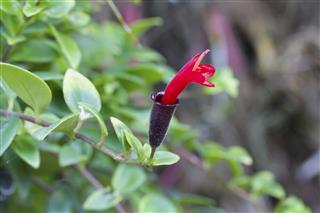
Lipstick plants are characterized by arching foliage and bright red to orange flowers. This article provides some tips to take care of this plant.
Lipstick plants belong to the genus Aeschynanthus, which consists of around 185 tropical herbs. They sport bright-colored flowers, and are native to the Indonesian islands, New Guinea, and Philippines. Though the most common species are Aeschynanthus lobbianus and Aeschynanthus radicans, they are popularly known as lipstick plants. These plants derive their name from the peculiar appearance of the flowers (of some species), which resemble open tubes of lipsticks.
Characteristic Features
The features of different species in the genus Aeschynanthus vary widely. Most of them are trailing or climbing epiphytes or lithophytes, which are grown as indoor houseplants, in hanging baskets. One of the most common species, called Aeschynanthus lobbianus, has glossy leaves with hard surfaces; and bright red-colored flowers emerging from tube-like calyx, which are dark red in color. Another popular species, Aeschynanthus radicans has leathery leaves, and the terminal scarlet-colored flowers have yellow throats. Aeschynanthus hildebrandii, looks different from others, as it has softer leaves and bright orange flowers. Species, like Aeschynanthus speciosus, are large; whereas Aeschynanthus micranthus is a small, trailing plant.
Lipstick Plant Care
These plants are very popular for their flowers and the different types of foliage. Being trailing plants, most of them are grown in hanging baskets. As they are native to tropical regions; lipstick plants need humidity, moisture, and sunlight, for a healthy growth. Sunlight is one of the important factors that can affect the growth of these plants; but direct sunlight can cause adverse effects, unless you keep the plants moist. It is always better to grow these plants in a location, which is warm, a little sunny and shady. If the plant is placed in direct sunlight, the leaves can fall off or turn brown. You can avoid this, by keeping the plant as well as the soil moist.
Another important factor relating to lipstick plant care is watering. Water these plants generously, but take care not to make the soil soggy. Regular watering is more important during summers and in dry weather conditions, wherein you have to moisten the leaves too. It is always better to use tepid water rather than cold water, as the latter may cause spots on the leaves, that may also turn brown.
While growing lipstick plants, you have to take care of the humidity levels. These plants require a humid atmosphere. In case of outdoor plants, regular misting can maintain the humidity levels, but as far as indoor lipstick plants are concerned, a humidifier can help to a great extent. Otherwise, you can place the plant in a tray filled with water and pebbles. You can even keep the plant in a bathroom window sill or kitchen.
Adding fertilizers during the spring and summer season, can trigger flowering in these plants. Use a nitrogen-free fertilizer at half the recommended strength, once in two weeks. The fertilizing and watering frequency has to be reduced during the fall and winter, to allow the plant to get a resting period. You may also trim these plants, after the flowering season. As the flowers emerge from the tips of the stalks, excessive trimming can hamper with flowering.
The plant can withstand day temperatures of above 75°F, and 65 to 70°F during the night; but the night temperatures should not be below 55°F. As far as potting is concerned, the soil must be loose and well-drained. It should be high in potassium and, must contain sphagnum peat moss and sharp sand or perlite. Re-potting should not be frequent.
You can grow them as outdoor or indoor plants. It is a visual treat with its attractive flowers and the wonderful foliage.

